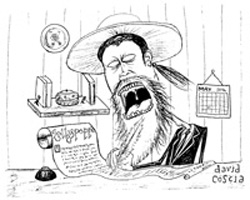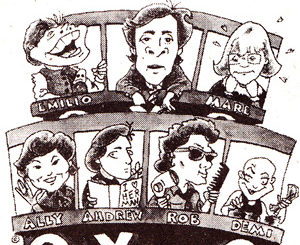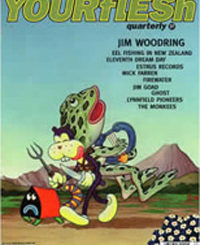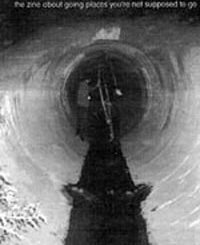 100 Years of Lollitude (Give or take 97)
100 Years of Lollitude (Give or take 97)
by William Ham
Illustration by David Coscia
Three years. Longer than the Kennedy administration, the Korean War, or even Chicago IV: Live at Carnegie Hall. Who’da thunk that this simple local rag, incepted on a wing, a prayer, and a handful of pseudoephedrine sulfate, would have grown, mutated, developed opposable thumbs, and matured into the juggernaut of jiggerypokery that you are now skimming quickly through on the newsstand while the Croatian with the filthy apron and the inside-out ski cap that runs the place mutters “This ain’t not being no library, heretic!” at you, in a mere 36 months? It boggles the mind and emplaquens the teeth to think of it. But for me, a Lollipopinjay of nearly two years’ standing (and at least six months’ squatting and picking bugs from the fur of our more hirsute staffers), the more interesting, and less-noted, tale is of how long it took Lollipop to get off the proverbial ground. Ninety-seven years, to be exact.
It all started in June, 1896, when Charles Foster Hefflon, an employee of America’s first convenience store, Shoppe 24, accidentally ingested an opium-laced sarsaparilla and had a vision. He recorded the epiphany in his journal:
June 14, 1896 – I see a stately pleasure dome rising high above the glittering fields of Xanadu with a circular floor within, upon which men and womenfolk circumnavigate using shoes with wheels upon them to the sound of a pipe organ. Oh yes, and I thought I might start a music and entertainment periodical to be published ten times a year. Excuse me, break’s over.
Thus inspired, Hefflon cobbled together his life savings (which was unfortunate, since cobbled currency had been rendered non-negotiable several months before) and put together the first issue of Lollipop. It wasn’t much at first – Issue #1 was only half a page in length and two-thirds of that was the logo – but his vision was unprecedented. As he put it in his first editorial, entitled “Overture to a Tongue-lap”: “I really have nothing better to do with my time.” (An aphorism that remains our motto to this day.) It was technically rough – all 10,000 copies were hand copied by an unknown friend of the editor whom he kept chained to his wood stove – but it contained several firsts: the first-ever record review (of Thomas Edison’s first cylinder, Untitled), the first known appearance of the term “ass-kicking” (same review), and the first recorded case of carpal tunnel syndrome (the editor’s friend). It also contained an exhortation from Hefflon soliciting contributions. “Would someone else please come and write this?” it read. “I would prefer to do as little of this as possible and still have the largest name on the masthead.”
Stirring words, and soon enough, the makeshift office Hefflon had constructed from teakwood atop an abandoned desk in Cambridge was filling up with potential contributors, and with ants, which drove away most of the potential contributors. A few, however, remained: Kilmer Joyce, a political writer and sometime botanical poet newly arrived in the States after being run out of his native Ireland for publishing a modest proposal entitled Let’s Eat Our Kids; Tex Marburger, a salad-oil baron and expert on music, leather, and music about leather; and my own great-grandfather, Gree Nexon Ham, who had merely wandered into the office looking for things to sniff and was immediately given a job. The core team in place, Issue #2 (Aug. 1896) was a great leap forward – it was now almost a full page and the logo was even bigger. No one could think of anything new to write about so they reprinted the previous issue in its entirety, but put it all in caps so no one could accuse them of repeating themselves. Which they ended up doing anyway, reprinting the same issue monthly for the next three years and changing only the issue number, working on the oft-stated tenet that “nobody cares anyway.” (An aphorism that would be our motto if Spun hadn’t taken it first.)
The turning point came in June, 1899, when Kilmer Joyce awoke one night, inspired and sweaty (later the title of his autobiography), and feverishly wrote his first political commentary, “Lincoln – Why No Mustache?” in a single draft. Hefflon was impressed. After the impression wore off and he was able to see again, he read the piece and liked it. It had even inspired him to write a new article of his own, “Yeah, What He Said.” These two pieces, in addition to the first in Marburger’s award-losing series “What Makes Me Drunk” and Gree Nexon’s groundbreaking satirical column, “Jokes I Stole From Mark Twain,” were sure to cement Lollipop‘s reputation. Regrettably, arguments over distribution (some on the staff thought that they should start letting other people read it) led Hefflon to institute minor cutbacks. Frequency of publication was reduced from monthly to once every year a sock puppet was elected to public office. (As a result, Issue #4 did not appear until 1912, the year of “Buttoneye” Hanes’ successful congressional bid.) Lollipop attempted to resume regular publication in 1914, but went on forced hiatus after the controversy surrounding Kilmer Joyce’s article in Issue #6, “Would Someone Please Just Shoot That Archduke Ferdinand?”
By the time production resumed, Lollipop faced heavy competition from newly-founded “magas” like The Saturday Evening Pit and MaximumJazzNSwing, but held its own all through the twenties. (Except for 1927, when they made someone else hold its own because its arms were tired.) Charles Foster Hefflon stepped down in 1929, having decided that becoming a stockbroker was the safer course. He passed the editorial baton (now visible in the dumpster behind the Smithsonian) to his nephew, F. Scott Hefflon. Under his regime, Lollipop expanded to two full pages and added many new and/or exciting artists and writers to the roster. (The cover of Issue #9 [Mar.’30] was executed by a German art-school dropout named Adolf Schicklgruber, who later changed his last name and decided to give politics a whirl.) Other changes were afoot as well. Kilmer Joyce resigned after Hefflon refused to print a piece by his cousin, James. “It doesn’t make any sense,” said Hefflon. “I don’t know about this Finnegan character, but nobody else is gonna wake after reading this.” Marburger and Ham changed their columns to “What I’m Not Allowed To Drink By Law” and “Jokes I Stole From S.J. Perelman” respectively. Lollipop became required reading at speakeasies and American Communist Party meetings across the country, and terms coined by the magazine like “23 skidoo” and “be-bop as fuck” became national catch phrases. So heady was the atmosphere surrounding Lollipop that no one seemed to notice that, during the latter half of the thirties, most issues consisted of hastily-scribbled notes reading “I.O.U. one music and entertainment magazine.” By the end of the decade, publication had ground once again to a halt, due to Hefflon’s well-publicized struggles with the FBI. The gentle wit of his editorial, “Hoover Sucks” (Issue #12, Apr. ’40), was obviously misinterpreted by the notoriously humorless head of the FBI, who arrived unannounced at one of Lollipop‘s famous parties at the Ritz Motel (“Crackers In Every Bed – That’s A Promise”) and slapped him with both a summons to appear before a Senate subcommittee and his official Bureau pocketbook.
It was the beginning of a dark chapter in Lollipop‘s history. The Senate Subcommittee On Things We Don’t Like took Hefflon to task and left him there without cab fare. He was branded “a menace to the American way of life and someone who can’t even tie a Windsor knot correctly,” as Senate custodian Will Scrubb put it. The actual senators didn’t like him much either. A dozen years before the advent of McCarthyism, Hefflon’s was the first name on the Government’s blacklist, a historical fact largely unknown due to the fact that names don’t show up very well when written on black paper. (Remember, this was nearly a decade before the ratification of the Let’s Not Take Things Quite So Literally law.) He was ordered to cease production, pay $80,000 in back taxes, and enroll in a cravat knotting course. This would have ruined a lesser man, but Hefflon’s motto was “never say die unless you’re already dead, in which case you’re not saying much of anything.” He decided to move the entire operation underground and produce the magazine off the coast of America and maybe get some sun in the bargain. So on December 6, 1941, he relocated Lollipop‘s editorial headquarters to the town of Pearl Harbor, Hawaii.
For some reason, no new issues ever appeared.
Over the next fifty years, several more abortive attempts at reviving the magazine were attempted. In 1956, Hugh Hefflon, a self-described self-descriptive type, resumed publication with a fresh vision: Fewer music reviews (“It is obvious that this rock ‘n’ roll fad will never last. I have seen the future of music and its name is skiffle.”) and more cheesecake photos. (He later expanded his coverage to include Jell-O and pie.) In order to avoid the errors of his predecessors, he sought out corporate backing to insure Lollipop‘s solvency, receiving support from the DuMont television network and the Edsel Motor Corporation. His writing was justly famed as well – not the stuff in the magazine, which pretty much blew, but his rejection letters were praised as some of the best of his generation. A representative sampling:
Dear Mr. Kerouac, What’s the big deal? I’ve been on the road, too – I took the Studebaker to Flagstaff last summer and you don’t see me mewling about it for 20,000 words. Your style, too, could use some work. It seems weary, tired -you sound kind of beat.
Dear Mr. Salinger, I have to be honest. If I wrote like this, I’d be too ashamed to ever leave my house.
Dear Mr. Bruce, That mouth of yours is gonna get you into trouble one of these days.
Yet, even with the stellar group of second- and third-generation Lollipoppers (such as DeWitt Joyce, Ander Marburger, Tag “Dorsal” Phinney, Buckskin Brown, and my own uncle Glazed) Hefflon had assembled, things were far from hunky or dory at the magazine. The attempts at branching out (such as the Lollipop Clubs in Havana and the Suez Canal and Hefflon’s short-lived TV series, Lollipop After Lights Out, which consisted mostly of the editor stumbling drunkenly around his one-room Lollipop Mansion and vomiting on guest stars Buddy Rich, Mort Sahl and Whittaker Chambers) had left him destitute and desperate. The magazine fell by the wayside, where it was later found by a passing vagrant and used as trash-barrel kindling.
From October, 1963 (featuring “The President Needs Vietnam Like He Needs A Hole In His Head” by DeWitt Joyce) to June, 1967 (including “The Beatles Are Dead – Long Live Vanilla Fudge” by Hefflon), Lollipop published exactly two issues. Staffers came and went. A copyboy named Lester Bangs was thrown forcibly from the premises for insistently playing a record by a band called the Velvet Underground when everyone really wanted to hear something good like “Sugar Sugar.” A fledgling journalist named Hunter S. Thompson was rejected out of hand by Hefflon: “You’re supposed to be covering the election! Nobody wants to read about how many drugs you took while you were writing this! What are you, gonzo or something?”
Finally, Hefflon threw in the towel and abandoned the publishing world for good in 1972, opting to work full-time for Harold Stassen’s presidential campaign. Lollipop, after 76 years and almost twenty issues, was well and truly dead.
That is, until a young, idealistic, and amiably sociopathic fellow named Scott hit upon the unprecedented notion of starting up a monthly periodical dedicated to music and entertainment one fine day in 1993. Few thought it would last; fewer still thought it would make the impact on world culture and the sale of second-hand thesauruses that it has. But we’ve shown them. Now, I could have spent all this valuable column space talking about my experience with Lollipop in the last two years, the crazy all-night soirées, and the individual, irreplicable talents of folks like Thorndike, Lavorich, Dauthi, Rainey, and Tremain. In fact, that was my assignment. But I believe in my heart of hearts that to know where we’re going, it’s best to know where we’ve been. Besides, telling the truth about Lollipop in the nineties would only leave to a sheaf of lawsuits that I couldn’t possibly afford. I mean, Ramen noodles are six for a dollar and I can only afford four of them. So leave me alone. It’s late and there’s huffing to do.



